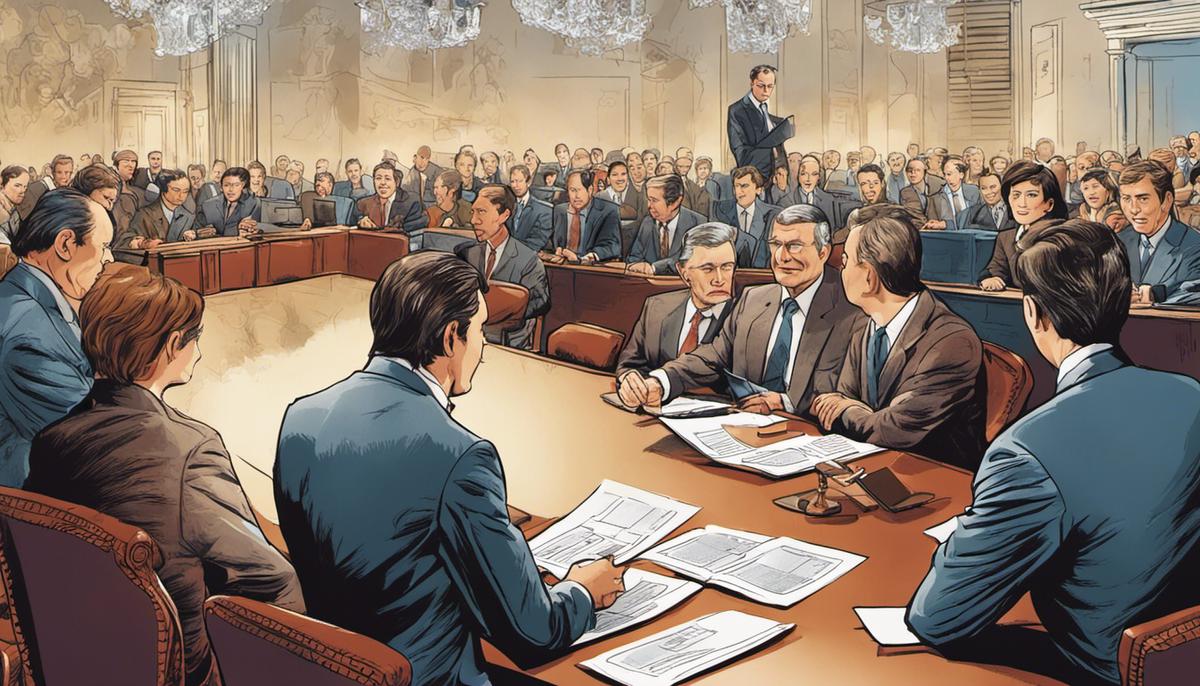In a diverse and rapidly changing business landscape, exceptional leadership is more crucial than ever for all industries and fields. This discourse delves into the nuances of successful leadership in the contemporary professional environment, marked by diverse team dynamics and multifaceted organizational objectives. A central theme guiding our investigation is the advent of key leadership styles such as transformational, democratic, transactional, and autocratic, and their respective implications on productivity and employee motivation. We also peer into the pivotal role of effective communication as a leadership skill, complimented by accurate active listening, giving constructive feedback, and promoting open communication.
Identifying Key Leadership Styles
Transformational Leadership Style
Transformational leadership is characterized by an emphasis on fostering creativity, innovation, and change. Leaders following this style motivate their team through a compelling shared vision and by acting as role models. They encourage personal and professional development within their team, ultimately promoting a high level of performance and engagement. They inspire employees to go beyond their self-interests for the good of the organization. This style is particularly effective in dynamic and rapidly changing work environments. Key skills associated with transformational leaders include empathy, delegation, resilience, creativity, and agility.
Democratic Leadership Style
Democratic, or participative, leadership style characterizes leaders who value active participation and consensus from their team in the decision-making process. They encourage open communication and ensure their team members feel valued and heard. This inclusive approach can lead to high team morale and increased creativity. However, decisions may take longer compared to more centralized leadership styles. A democratic leader’s top skills often include active listening, effective communication, collaboration, empathy, and patience.
Transactional Leadership Style
Transactional leadership involves a leader setting clear standards and objectives, and rewarding or punishing team members based on their performance. They maintain contingencies and establish clear expectations. While this type of leadership can lead to efficiency and predictability, it may not inspire employees or nurture their full potential. It is most effective in scenarios where procedures need to be followed and tasks have to be executed efficiently. In this style, effective communication, planning, time-management, and decision-making skills are commonly seen.
Autocratic Leadership Style
Autocratic leadership is marked by centralization of power and decision-making in the leader. They have full control over their team and seldom solicit their inputs. This style can be effective in situations with tight deadlines or when decisions need to be made quickly. It is also beneficial when team members may not have enough expertise or understanding to contribute effectively to decision-making. However, this style can also lead to demotivation and dissatisfaction among team members, especially when used excessively. Key skills associated with autocratic leadership include decision-making, assertiveness, strategic planning, and more.
The Impact of Leadership Styles on Team Dynamics and Performance
Leadership styles have a profound influence on both team dynamics and productivity. For example, transformational and democratic leadership approaches tend to inspire an inclusive, engaging, and proactive workplace. These settings often stimulate innovation, team involvement, and increased productivity. Conversely, transactional and autocratic leadership styles, while efficient in task completion, risk inhibiting innovation and lowering team morale over the long haul.
It’s crucial for effective leaders to comprehend and adjust their leadership approach based on their team’s situation and individual needs. By honing key skills, like emotional intelligence, strategic thinking, and effective communication, leaders can make the most of each leadership style’s benefits.

Communication as a Leadership Skill
Mastering the Art of Communication
Good communication is a pivotal leadership skill that applies across all professional fields. It’s the essential link between leaders and their teams, acting as the key conduit for translating a leader’s vision into action by team members. To master this skill, leaders must grasp the foundations of active listening, offering constructive feedback, clearly articulating their vision, and nurturing an environment that welcomes open dialogue.
Active Listening in Leadership
Active listening underscores the importance of understanding and interpreting what team members are saying for leaders. It involves not just hearing the words spoken but also engaging with the subtext, interpreting nonverbal cues, seeking clarification, and offering affirmations or further questions. An effective leader listens more than they speak and through this, they gain in-depth insight into the needs, ideas, and feelings of their team members. This understanding fosters empathy, trust, and builds stronger relationships within the team, forming a solid foundation for collaboration and productivity.
Importance of Constructive Feedback
Constructive feedback is another crucial aspect of communication in leadership. It involves communicating effectively and diplomatically about performance, behavior, or a particular outcome. Well-delivered feedback creates an opportunity for growth, learning, and improvement, which are all important elements in a successful team. Regular feedback not only lets individuals know how they’re doing but it also fosters ongoing dialogue and strengthens relationships between leaders and team members.
Vision Communication Tactics
A leader is often entrusted with the task of setting a direction for a team, a department, or an entire organization. In order to motivate people to follow this direction, the vision must be communicated clearly and convincingly. Leaders use storytelling, metaphors, symbols, and concrete examples to convey their visions in a way their teams can easily understand and connect with.
Creating an Environment for Open Communication
An effective leader encourages open communication within their team. They foster an environment where each team member feels comfortable expressing their views, feedback, and ideas. They ensure that every opinion is valued and considered and that it contributes to the decision-making process. This approach creates a culture of openness, trust, and collaboration, enhancing team cohesion and effectiveness in achieving set goals.
The Pillars of Leadership: Communication
Undoubtedly, effective communication is one of the cornerstones of leadership. It involves not just delivering a clear message, but also listening actively, giving substantial feedback, persuasively expressing visions, and fostering an atmosphere where open dialogue is celebrated. Through successful communication, leaders can dramatically dictate the course their teams and organizational culture take.

Motivation and Team Building
The Role of Motivation in Effective Leadership
Further building on the concept of successful leadership is the ability to inspire and motivate one’s team. This motivation functions as the catalyst that encourages team members towards realizing the company’s set goals. Proficient leaders are skilled in manipulating this catalytic force, thus ensuring increased productivity and cultivating a favorable work environment.
Theories of Motivation: Understanding What Drives People
There are many theories of motivation that leaders can lean into, such as Maslow’s Hierarchy of Needs, Herzberg’s Two-Factor Theory, and McGregor’s Theory X and Theory Y. These theories provide insights into what motivates employees and how leaders can tap into these motivations to stimulate productivity and engagement.
For example, Maslow’s Hierarchy of Needs suggests that people are motivated to meet certain needs in a hierarchical order: physiological, safety, love and belonging, esteem, and self-actualization. By understanding this, leaders can prioritize meeting those basic needs before moving onto more complex ones, thus creating a healthy, motivated team.
Incentivizing Teams: Recognition, Rewards, and More
The act of incentivizing teams beyond their salaries is an effective way to increase motivation. This could be through recognition programs, bonuses, promotions, or opportunities for professional development. Recognition for a job well done can boost morale, enhance job satisfaction, and inculcate a sense of pride in team members, which reflects in their performance.
Leaders can also arrange regular performance reviews to address individual and team progress towards goals, strengths, weaknesses, and areas for improvement. Providing timely and constructive feedback will also ensure that team members feel valued and understand their role in the bigger picture of the organization’s success.
Building Strong, Cohesive Teams: Strategies for Success
Building strong, cohesive teams is not a one-time act but an ongoing process. A critical element to creating a unified team is fostering a culture of mutual respect and trust. Leaders can accomplish this by setting clear expectations, maintaining open and transparent communication, and encouraging collaboration.
Another crucial factor for cohesive teams is diversity, which drives innovation through varying opinions, ideas, and solutions. Leaders should also invest time in team-building activities and initiatives that promote bonding and understanding among team members.
Lastly, conflict resolution is key to maintain a healthy team dynamic. Leaders must act as mediators in disputes and work towards fair solutions, maintaining a peaceful work environment that encourages collaboration rather than competition.
Conclusively, an efficacious leader needs more than strategic thinking and decision-making skills. They must also have a profound understanding and implementation of motivation and team-building strategies. By imbibing these practices, leaders don’t just create highly motivated and uniform teams but also instil a driving force for the organization’s success.

Strategic Thinking and Decision Making
Exploring Strategic Thinking and Decision Making in Leadership
Leaders across all fields bank on strategic thinking and decision-making skills to guide their operations. Such skills equip them with the capability to formulate long-term objectives that are in line with their organization’s vision and goals. By doing so, leaders can sketch a clear roadmap to success, bolstering their organization’s productivity, competitiveness, and sustainability.
Strategic thinking in leadership encompasses the skills of forecasting, foresight, and scenario planning. It requires a thorough review of historical data coupled with superior analytical and critical thinking abilities to foresee future events or trends. Such an attribute gives leaders the reins to navigate their organization towards its anticipated goals in a constantly changing landscape, deftly sidestepping potential obstacles.
Developing Strategic Plans
Developing strategic plans is another crucial responsibility of leaders. It involves setting the direction and defining the strategies that an organization will follow to achieve its objectives. As a sequence, leaders must first define the mission and vision statements that provide a viewpoint of the organization’s future.
Following that, they have to analyze the current state of the organization with tools like SWOT (Strengths, Weaknesses, Opportunities, Threats) analysis to identify the internal and external factors that can affect their plans. They then set goals and objectives that align with the mission and vision. These objectives should be Specific, Measurable, Achievable, Relevant, and Time-bound (SMART), providing a clear and attainable roadmap.
After setting the goals, leaders have to develop the strategies, action steps, and timelines to achieve these goals and regularly monitor and review these strategies to ensure they are effective and adjusted as necessary.
Improving Problem-Solving Abilities
Another essential leadership trait is the ability to solve problems effectively. Leaders often face complex and challenging situations that require innovative and efficient solutions. They need to exhibit critical and analytical thinking skills to assess the problem accurately, generate possible solutions, evaluate the different courses of actions, and make the appropriate decision.
Improving one’s problem-solving abilities often involves consistently challenging and stretching oneself beyond one’s comfort zone. This often means seizing lending ears to feedback from different quarters, embracing diversity of thought, and driving a learning culture that encourages experimentation and learning from failures.
Making Informed Decisions
Making well-informed decisions is another important leadership skill. Such decisions rely on a thorough evaluation of the various options and their potential impacts on the organization’s goals. It involves gathering and analyzing relevant data, consulting with subject matter experts, considering multiple perspectives, and anticipating potential outcomes and consequences.
Decision-making is also about taking calculated risks. Leaders must often make decisions even when information is limited or the outcome uncertain. Thus, good leaders cultivate a certain level of tolerance for ambiguity and are skilled at adapting their decision-making process, depending on the situation’s context and urgency.
Effective leadership is rooted in the power of strategic thinking and decision-making skills. It involves comprehensive strategic planning, adept problem-solving skills, and informed decision-making processes. By honing these skills, leaders are able to smoothly navigate their organization towards success, yielding long-term benefits for both their teams and the organization as a whole.

Ethics and Leadership
Underpinning Leadership with Ethical Considerations
An eminent component of successful leadership is having a strong ethical framework. Ethics, encompassing the beliefs and values that dictate an individual’s behavior, carry significant weight in shaping a leader’s reputation and their ability to influence within an organization. Leaders who uphold high standards of ethics are consistently proven to be more efficient in their roles, capable of inspiring their teams, and driving their organizations towards success.
Ethics, Reputation, and Influence
Ethical leaders demonstrate a commitment to fairness, respect for others, and dedication in their actions. This ethical behavior directly contributes to their reputation within the organization. A robust, positive reputation leads to increased trust from team members, which translates into greater influence for the leader. Team members are more likely to follow leaders they perceive as ethical and fair in their decision-making process.
Ethics and Trustworthiness
Trustworthiness is an essential aspect of leadership. Leaders who act with integrity earn the trust of their team members, and this trust is crucial for effective leadership. Ethical leaders demonstrate consistency in their actions and the decisions they make, thereby demonstrating their reliability. They show transparency in their actions, are accountable for their decisions, and respect the rights and dignity of others. This consistent ethical behavior over time builds trust and credibility, which are vital for effective leadership.
Impact on Performance
Ethics in leadership also significantly impacts the overall team and organizational performance. Ethical leaders drive a positive work culture that promotes teamwork, fairness, and mutual respect. This kind of environment encourages team members to perform at their best, leading to enhanced productivity and performance. Ethical leadership also minimizes internal conflicts and promotes a healthy working environment since team members feel respected and valued.
Addressing Ethical Dilemmas in Leadership
Leaders often encounter ethical dilemmas in their roles. These could range from conflicts of interest, pressure to achieve results at any cost, to dealing with dishonesty or misbehavior within the team. Addressing these dilemmas requires strong ethical responsibility, judgment, and communication skills. Ethical leaders should uphold their values in the face of such dilemmas, make decisions that align with these values, and communicate openly and honestly with their team. They should acknowledge mistakes when they occur, learn from them, and take appropriate corrective action.
Leading by Example
One of the best ways leaders can encourage an ethical culture within their teams is by leading by example. This approach involves demonstrating ethical behavior in all actions and decisions and emphasizing the importance of ethics in all business operations and strategies. By doing so, leaders reinforce the significance of ethical behavior, demonstrating that it’s not just about doing the right thing but also about contributing to the overall success of the organization.
In conclusion, ethics play a critical role in leadership, shaping a leader’s reputation, influence, trustworthiness, and overall team performance. They are a cornerstone that enables leaders to navigate difficult decisions, build robust teams, and ultimately, achieve sustainable success.

Acting as a guide throughout the challenges and benefits of ethical leadership, we have provided an extensive dissection of how ethical practices determine leadership credibility, influence, trust, and overall team performance. Furthermore, the discourse highlighted how leaders have to respond to ethical dilemmas. We hope this exploration of leadership skills aids you in recognizing and cultivating these vital skills within your professional journey, inspiring you to become adaptable, strategic decision-makers and ethical leaders in your respective domains. Through a continuous commitment to communication, motivation, strategic thinking, and ethics, we believe every individual has the potential to become an influential leader.
